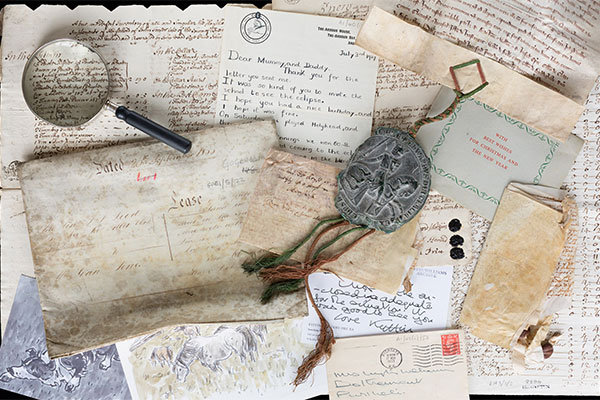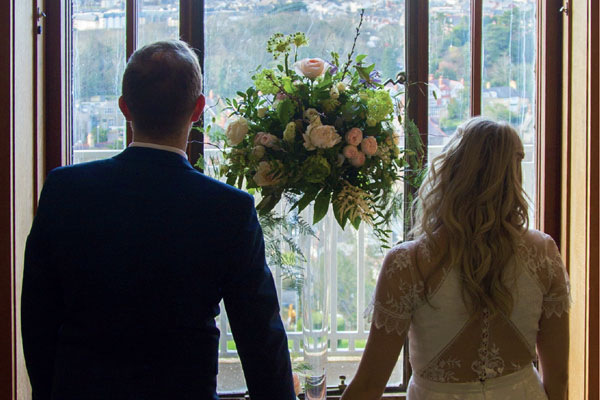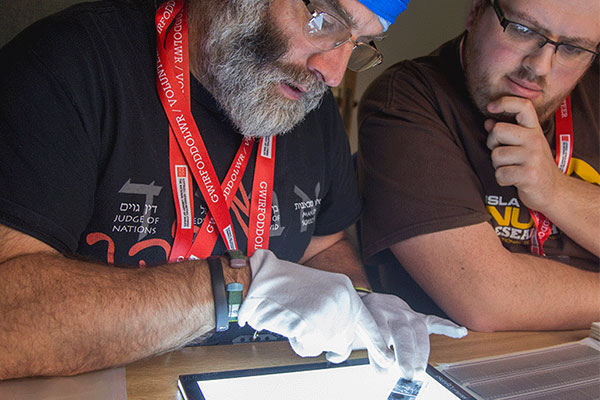If you delve into the NLW Archives, you will find they are full of different sources marking individual days that have, over time, become historical. One of these days is one we’re thinking about today, and that is VE Day.
A BBC news bulletin from May 7th 1945 showed the world waiting with bated breath for an announcement they had been hoping to hear for almost 6 years. There were already whispers that the fighting had stopped, and Winston Churchill was set to announce the end of the War.

A news report from a day later, May 8th, broadcast at 5.15 from Caernarfon, tells of flags being waved as VE Day celebrated. People lined the streets and singing could be heard. It speaks of the day that will live on in history, notes that a painting of David Lloyd George overlooks the celebrations, the man who led the country in the last war:
‘...un o’r dyddiau a fydd byw mewn hanes. Y mae muriau’r hen gastell, a welodd lawer brwydr, yn edrych i lawr arnom, ac o’u blaen y mae cerflun David Lloyd George, y gŵr a arweiniodd y wlad yn y rhyfel diwethaf.’
(E. Morgan Humphreys, E/215, 8 May 1945)
The Welsh photographer Geoff Charles (1909-2002) recorded some of the celebratory scenes at the end of the war on camera. His archive includes images of the peace and victory party held at Newtown in 1945, with the blurring images capturing the frenetic energy of those who had just come out of six years of war.


The Newport and District Amateur Film Society captured the city’s celebrations. Organisations that contributed to the successful war effort were represented in the parade which included the St. John’s Ambulance Brigade and the WVS (Women’s Voluntary Service) amongst others. The film was digitised as part of the BFI’s Unlocking Our Heritage project and be viewed for free on the BFI Player, or on the Peniarth Screen at NLW for a limited time.

The novelist Berta Ruck (1878-1978) was living in Aberdyfi at the time of the announcement that the war in Europe had ended. The library holds an extensive collection of her notebooks which offer a glimpse into how the news was received in her corner of Wales, with an entry dated 8th May 1945 reading:
‘At 3 Churchill proclaimed the official end of war in Europe . . . . . . . Then the ships made a terrific rumpus with sirens & shooting & hooting and the flags fluttered & everything began at long last to seem gaye.’
(Berta Ruck Archive, NLW MS 23744D, 8 May 1945)
The view further north in Llandudno was equally jubilant. The papers of J. Haulfryn Williams (1908-1980), later Secretary of the Honorable Society of Cymmrodorion, described the scene in town following the news:
‘After hearing the Prime Minister’s announcement at 3.00 that hostilities in Europe had ceased and that terms of unconditional surrender had been signed at 2.41 yesterday morning . . . The town was crowded, everyone in high spirits. A dull morning had changed to a warm sunny afternoon’
(J. Haulfyn Williams Papers 18, 8 May 1945)
After the celebrations came to an end, it was time for reflection. On the Sunday following ‘V day’ as it was referred to at the time, Rev. Gwilym Davies shared a message at the Temple of Peace. He remembers ‘those who have suffered by reason of the war, the broken in body, mind and spirit and the homes in our midst darkened by sorrow.’ He wonders what the future will bring and shares his thoughts on peace:
‘Will it find us, one by one and day by day, dedicated, humbly and wholly, the winning of the greater victory of the peace?’
(Rev. Gwilym Davies Papers, May 13th 1945).
Category: Article





